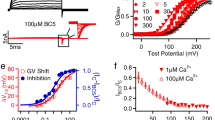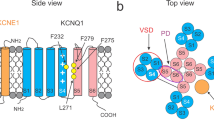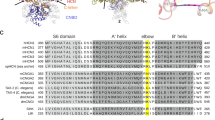Abstract
Large-conductance Ca2+-gated K+ (BK) channels are essential for many biological processes such as smooth muscle contraction and neurotransmitter release1,2,3,4. This group of channels can be activated synergistically by both voltage and intracellular Ca2+, with the large carboxy-terminal intracellular portion being responsible for Ca2+ sensing5,6,7,8,9,10,11,12,13. Here we present the crystal structure of the entire cytoplasmic region of the human BK channel in a Ca2+-free state. The structure reveals four intracellular subunits, each comprising two tandem RCK domains, assembled into a gating ring similar to that seen in the MthK channel14 and probably representing its physiological assembly. Three Ca2+ binding sites including the Ca2+ bowl are mapped onto the structure based on mutagenesis data. The Ca2+ bowl, located within the second RCK domain, forms an EF-hand-like motif and is strategically positioned close to the assembly interface between two subunits. The other two Ca2+ (or Mg2+) binding sites, Asp 367 and Glu 374/Glu 399, are located on the first RCK domain. The Asp 367 site has high Ca2+ sensitivity and is positioned in the groove between the amino- and carboxy-terminal subdomains of RCK1, whereas the low-affinity Mg2+-binding Glu 374/Glu 399 site is positioned on the upper plateau of the gating ring and close to the membrane. Our structure also contains the linker connecting the transmembrane and intracellular domains, allowing us to dock a voltage-gated K+ channel pore of known structure onto the gating ring with reasonable accuracy and generate a structural model for the full BK channel.
This is a preview of subscription content, access via your institution
Access options
Subscribe to this journal
Receive 51 print issues and online access
$199.00 per year
only $3.90 per issue
Buy this article
- Purchase on Springer Link
- Instant access to full article PDF
Prices may be subject to local taxes which are calculated during checkout




Similar content being viewed by others
References
Kaczorowski, G. J., Knaus, H. G., Leonard, R. J., McManus, O. B. & Garcia, M. L. High-conductance calcium-activated potassium channels; structure, pharmacology, and function. J. Bioenerg. Biomembr. 28, 255–267 (1996)
Latorre, R., Oberhauser, A., Labarca, P. & Alvarez, O. Varieties of calcium-activated potassium channels. Annu. Rev. Physiol. 51, 385–399 (1989)
Cui, J., Yang, H. & Lee, U. S. Molecular mechanisms of BK channel activation. Cell. Mol. Life Sci. 66, 852–875 (2008)
Magleby, K. L. Gating mechanism of BK (Slo1) channels: so near, yet so far. J. Gen. Physiol. 121, 81–96 (2003)
Wei, A., Solaro, C., Lingle, C. & Salkoff, L. Calcium sensitivity of BK-type KCa channels determined by a separable domain. Neuron 13, 671–681 (1994)
Schreiber, M. & Salkoff, L. A novel calcium-sensing domain in the BK channel. Biophys. J. 73, 1355–1363 (1997)
Bao, L., Kaldany, C., Holmstrand, E. C. & Cox, D. H. Mapping the BKCa channel’s “Ca2+ bowl”: side-chains essential for Ca2+ sensing. J. Gen. Physiol. 123, 475–489 (2004)
Zhang, X., Solaro, C. R. & Lingle, C. J. Allosteric regulation of BK channel gating by Ca2+ and Mg2+ through a nonselective, low affinity divalent cation site. J. Gen. Physiol. 118, 607–636 (2001)
Bao, L., Rapin, A. M., Holmstrand, E. C. & Cox, D. H. Elimination of the BKCa channel’s high-affinity Ca2+ sensitivity. J. Gen. Physiol. 120, 173–189 (2002)
Xia, X. M., Zeng, X. & Lingle, C. J. Multiple regulatory sites in large-conductance calcium-activated potassium channels. Nature 418, 880–884 (2002)
Shi, J. et al. Mechanism of magnesium activation of calcium-activated potassium channels. Nature 418, 876–880 (2002)
Zeng, X. H., Xia, X. M. & Lingle, C. J. Divalent cation sensitivity of BK channel activation supports the existence of three distinct binding sites. J. Gen. Physiol. 125, 273–286 (2005)
Xia, X. M., Zhang, X. & Lingle, C. J. Ligand-dependent activation of Slo family channels is defined by interchangeable cytosolic domains. J. Neurosci. 24, 5585–5591 (2004)
Jiang, Y. et al. Crystal structure and mechanism of a calcium-gated potassium channel. Nature 417, 515–522 (2002)
Hou, S., Heinemann, S. H. & Hoshi, T. Modulation of BKCa channel gating by endogenous signaling molecules. Physiology 24, 26–35 (2009)
Jiang, Y., Pico, A., Cadene, M., Chait, B. T. & MacKinnon, R. Structure of the RCK domain from the E. coli K+ channel and demonstration of its presence in the human BK channel. Neuron 29, 593–601 (2001)
Albright, R. A., Ibar, J. L., Kim, C. U., Gruner, S. M. & Morais-Cabral, J. H. The RCK domain of the KtrAB K+ transporter: multiple conformations of an octameric ring. Cell 126, 1147–1159 (2006)
Roosild, T. P., Miller, S., Booth, I. R. & Choe, S. A mechanism of regulating transmembrane potassium flux through a ligand-mediated conformational switch. Cell 109, 781–791 (2002)
Kim, H. J., Lim, H. H., Rho, S. H., Eom, S. H. & Park, C. S. Hydrophobic interface between two regulators of K+ conductance domains critical for calcium-dependent activation of large conductance Ca2+-activated K+ channels. J. Biol. Chem. 281, 38573–38581 (2006)
Yusifov, T., Savalli, N., Gandhi, C. S., Ottolia, M. & Olcese, R. The RCK2 domain of the human BKCa channel is a calcium sensor. Proc. Natl Acad. Sci. USA 105, 376–381 (2008)
Wang, L. & Sigworth, F. J. Structure of the BK potassium channel in a lipid membrane from electron cryomicroscopy. Nature 461, 292–295 (2009)
Horrigan, F. T. & Aldrich, R. W. Coupling between voltage sensor activation, Ca2+ binding and channel opening in large conductance (BK) potassium channels. J. Gen. Physiol. 120, 267–305 (2002)
Lingle, C. J. Setting the stage for molecular dissection of the regulatory components of BK channels. J. Gen. Physiol. 120, 261–265 (2002)
Falke, J. J., Drake, S. K., Hazard, A. L. & Peersen, O. B. Molecular tuning of ion binding to calcium signaling proteins. Q. Rev. Biophys. 27, 219–290 (1994)
Gifford, J. L., Walsh, M. P. & Vogel, H. J. Structures and metal-ion-binding properties of the Ca2+-binding helix-loop-helix EF-hand motifs. Biochem. J. 405, 199–221 (2007)
Hou, S., Xu, R., Heinemann, S. H. & Hoshi, T. Reciprocal regulation of the Ca2+ and H+ sensitivity in the SLO1 BK channel conferred by the RCK1 domain. Nature Struct. Mol. Biol. 15, 403–410 (2008)
Yang, H. et al. Activation of Slo1 BK channels by Mg2+ coordinated between the voltage sensor and RCK1 domains. Nature Struct. Mol. Biol. 15, 1152–1159 (2008)
Niu, X., Qian, X. & Magleby, K. L. Linker-gating ring complex as passive spring and Ca2+-dependent machine for a voltage- and Ca2+-activated potassium channel. Neuron 42, 745–756 (2004)
Long, S. B., Tao, X., Campbell, E. B. & MacKinnon, R. Atomic structure of a voltage-dependent K+ channel in a lipid membrane-like environment. Nature 450, 376–382 (2007)
Yuan, P., Leonetti, M. D., Pico, A. R., Hsiung, Y. & Mackinnon, R. Structure of the human BK channel Ca2+-activation apparatus at 3.0 Å resolution. Science 10.1126/science.1190414 (27 May 2010)
Zerangue, N., Jan, Y. N. & Jan, L. Y. An artificial tetramerization domain restores efficient assembly of functional Shaker channels lacking T1. Proc. Natl Acad. Sci. USA 97, 3591–3595 (2000)
Harbury, P. B., Zhang, T., Kim, P. S. & Alber, T. A switch between two-, three-, and four-stranded coiled coils in GCN4 leucine zipper mutants. Science 262, 1401–1407 (1993)
Cronin, C. N., Lim, K. B. & Rogers, J. Production of selenomethionyl-derivatized proteins in baculovirus-infected insect cells. Protein Sci. 16, 2023–2029 (2007)
Otwinowski, Z. & Minor, W. Processing of X-ray diffraction data collected in oscillation mode. Methods Enzymol. 276, 307–326 (1997)
Schneider, T. R. & Sheldrick, G. M. Substructure solution with SHELXD. Acta Crystallogr. D 58, 1772–1779 (2002)
Vonrhein, C., Blanc, E., Roversi, P. & Bricogne, G. Automated structure solution with autoSHARP. Methods Mol. Biol. 364, 215–230 (2007)
Collaborative Computational Project, Number 4. The CCP4 suite: programs for protein crystallography. Acta Crystallogr. D 50, 760–763 (1994)
Emsley, P. & Cowtan, K. Coot: model-building tools for molecular graphics. Acta Crystallogr. D 60, 2126–2132 (2004)
Adams, P. D. et al. PHENIX: a comprehensive Python-based system for macromolecular structure solution. Acta Crystallogr. D 66, 213–221 (2010)
Acknowledgements
We thank A. Alam and M. Derebe for manuscript preparation; A. Pico for discussion in the early stages of this study; and X. Zhang for help in structure determination. Use of the Advanced Photon Source (APS) was supported by the US Department of Energy, Office of Energy Research. We thank the beamline (23ID and 19ID) staff for assistance in data collection. This work was supported by Howard Hughes Medical Institute and by grants from the NIH/NIGMS (RO1 GM071621) and Welch Foundation.
Author information
Authors and Affiliations
Contributions
Y.W. performed sample preparation and structure determination. Y.Y. performed protein expression and purification. S.Y. performed model building and refinement. Y.W. and Y.J. designed the research, analysed data and prepared the manuscript.
Corresponding author
Ethics declarations
Competing interests
The authors declare no competing financial interests.
Supplementary information
Supplementary Information
This file contains a Supplementary Discussion, Supplementary Figures 1-4 with legends and Supplementary Table 1. (PDF 1200 kb)
Rights and permissions
About this article
Cite this article
Wu, Y., Yang, Y., Ye, S. et al. Structure of the gating ring from the human large-conductance Ca2+-gated K+ channel. Nature 466, 393–397 (2010). https://doi.org/10.1038/nature09252
Received:
Accepted:
Published:
Issue Date:
DOI: https://doi.org/10.1038/nature09252
This article is cited by
-
Calcium-gated potassium channel blockade via membrane-facing fenestrations
Nature Chemical Biology (2024)
-
Mitochondrial potassium channels: A novel calcitriol target
Cellular & Molecular Biology Letters (2022)
-
Small molecule modulation of the Drosophila Slo channel elucidated by cryo-EM
Nature Communications (2021)
-
Ca2+-regulated Ca2+ channels with an RCK gating ring control plant symbiotic associations
Nature Communications (2019)
-
Molecular determinants of Ca2+ sensitivity at the intersubunit interface of the BK channel gating ring
Scientific Reports (2018)
Comments
By submitting a comment you agree to abide by our Terms and Community Guidelines. If you find something abusive or that does not comply with our terms or guidelines please flag it as inappropriate.



